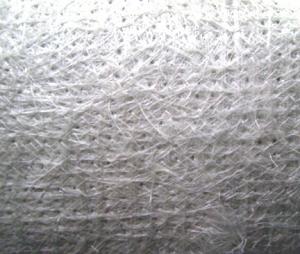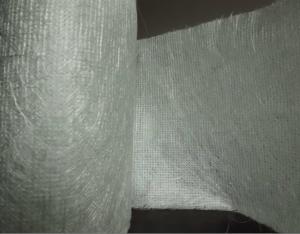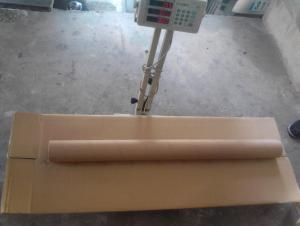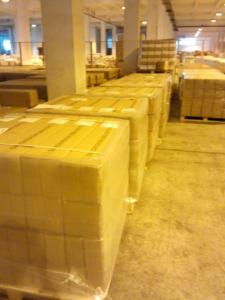E-GLASS Stitch Combo Mat- EMK
- Loading Port:
- China Main Port
- Payment Terms:
- TT or LC
- Min Order Qty:
- 1000 kg
- Supply Capability:
- -
OKorder Service Pledge
OKorder Financial Service
You Might Also Like
DESCRIPTION
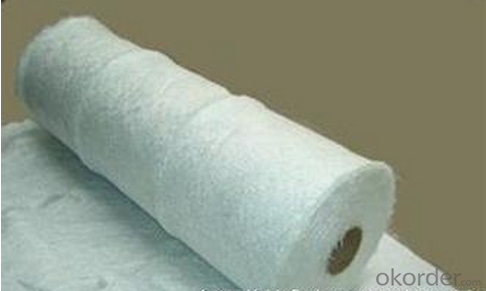
E-glass stitched combo mat consists of two or more layers of fiber glass rovings which arestitch-bonded. one layer of rovings and differene layers of rovings can beoriented differently and have different linear density. the rovingspecification, number of roving layers, mat width and roll diameter can becustomized as per requirement.

SPECIFICATIONS
| Product No | Overall Density | Woven Roving Density | Chop Density | Polyester Yarn Density |
| BH-ESM1808 | 896.14 | 612 | 274.64 | 9.5 |
| BH-ESM1810 | 926.65 | 612 | 305.15 | 9.5 |
| BH-ESM1815 | 1080.44 | 612 | 457.73 | 10.71 |
| BH-ESM2408 | 1132.35 | 847 | 274.64 | 10.71 |
| BH-ESM2410 | 1162.86 | 847 | 305.15 | 10.71 |
| BH-ESM2415 | 1315.44 | 847 | 457.73 | 10.71 |
APPLICATION:
Emulsion Chopped Strand Mat is mainly applied to unsaturated polyester ,viny ester and epoxyresins. The product is most widely used in hand lay-up process and also can be used in filament winding. compression molding and continuous laminating processes. The typical end products including various panels, boats,bath equipment automotive parts and cooling towers
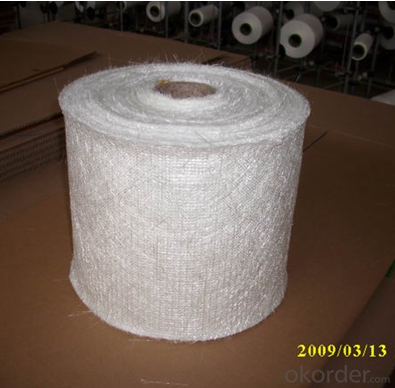
PACKAGE:
fiberglassstitched mat is wound onto paper tube and then wrapped up with plasticfilm, which can be packed in a cardboad box or kraft paper.the rolls are to behorizontallyplaced. rolls can be loaded into container diretly or on pallets.
FAQ:
1.What is the delivery time ?
15days after receiving the deposit
2.Are you a trading company or factory.
We are factory,and we have more than 10 years of experience.
- Q:How does fiberglass fabric perform in thermal conductivity?
- Fiberglass fabric, with its relatively low thermal conductivity, functions as a subpar heat conductor, thereby making it an exceptional insulating material. The composition of fiberglass fabric comprises delicate glass fibers, which possess low thermal conductivity due to their low density and absence of metallic elements. Consequently, fiberglass fabric effectively impedes heat transfer, preventing the temperature on one side of the fabric from impacting the other side. This renders it suitable for various applications requiring thermal insulation, including the construction of thermal blankets, oven insulation, and the lining of industrial equipment. Furthermore, the fiberglass fabric's low thermal conductivity significantly contributes to its fire-resistant properties, as it does not easily transfer heat to ignite or support combustion. In conclusion, fiberglass fabric excels in thermal conductivity by providing insulation and fire resistance.
- Q:Is fiberglass fabric suitable for aerospace applications?
- Yes, fiberglass fabric is suitable for aerospace applications. It is known for its lightweight, high strength, and excellent thermal resistance, making it ideal for various aerospace components such as aircraft interiors, insulation, and structural elements. Additionally, fiberglass fabric has good resistance to chemicals and fatigue, further enhancing its suitability for aerospace use.
- Q:How does fiberglass fabric perform in fire resistance?
- Fiberglass fabric possesses outstanding fire-resistant properties, renowned for its ability to withstand high temperatures and flames without burning or emitting smoke or toxic fumes. This fabric, woven from glass fibers, is inherently non-combustible. Additionally, it boasts a remarkably high melting point of approximately 1,200 degrees Celsius (2,192 degrees Fahrenheit), ensuring it remains intact and undamaged under extreme heat. Moreover, fiberglass fabric exhibits low thermal conductivity, impeding the transfer of heat. Consequently, it effectively curtails the spread of fire and safeguards adjacent areas from its reach, offering supplementary protection. Furthermore, to augment its fire-resistant attributes, fiberglass fabric is frequently treated with specialized coatings or finishes. These enhancements further fortify its resistance to flames, heat, and the propagation of fire. Owing to these exceptional fire-resistant qualities, fiberglass fabric is extensively utilized in a wide array of applications necessitating fire protection. It is commonly employed in industries such as aerospace, automotive, construction, firefighting, as well as in protective clothing and equipment. However, it is important to note that the effectiveness of fiberglass fabric as a fire-resistant material may be influenced by factors such as the fabric's thickness, quality, and specific composition. Therefore, it is crucial to meticulously select and verify the fire-resistant properties of fiberglass fabric in accordance with the particular requirements and standards of the intended application.
- Q:How does fiberglass fabric handle humidity?
- Fiberglass fabric has a remarkable ability to resist humidity. Unlike numerous other materials, it does not absorb moisture, thus making it highly resistant to the growth of mold and mildew. This quality makes fiberglass fabric an excellent option for use in environments with high humidity, as it remains undamaged and maintains its structural integrity when exposed to moisture. Furthermore, its resistance to humidity also renders it suitable for outdoor applications, as it can endure rain, fog, and other wet conditions without deteriorating. All in all, its capability to withstand humidity makes fiberglass fabric a durable and dependable material for various uses.
- Q:Can fiberglass fabric be used for insulation in breweries?
- Yes, fiberglass fabric can be used for insulation in breweries. Fiberglass fabric is known for its excellent insulation properties, as it has a low thermal conductivity and high resistance to heat transfer. This makes it an ideal material for insulating various applications, including breweries. Insulation in breweries is crucial to maintain specific temperature conditions for various processes involved in brewing, such as fermentation, mashing, and boiling. Fiberglass fabric can be used to insulate brewing vessels, pipes, and tanks, ensuring that heat is retained or prevented from entering the system, depending on the specific requirement. Fiberglass fabric is also resistant to moisture, which is essential in brewery environments where there may be high humidity levels or exposure to liquids. It does not absorb moisture, ensuring that its insulation properties are not compromised over time. Additionally, fiberglass fabric is easy to install and can be customized to fit different sizes and shapes, making it a versatile choice for insulation in breweries. It is lightweight and flexible, allowing for easy handling and installation in various areas of the brewery. Overall, fiberglass fabric is a suitable choice for insulation in breweries due to its excellent thermal insulation properties, moisture resistance, and ease of installation. It helps maintain optimal temperature conditions, improving energy efficiency and ensuring the quality of the brewing process.
- Q:Are fiberglass fabrics prone to fading or discoloration over time?
- Yes, fiberglass fabrics are generally not prone to fading or discoloration over time. They are known for their durability and resistance to fading, making them a reliable option for long-term use.
- Q:How does fiberglass fabric perform in extreme temperatures?
- Fiberglass fabric performs exceptionally well in extreme temperatures. It has a high resistance to heat and can withstand both very low and very high temperatures without losing its structural integrity. This makes it suitable for various applications, including insulation, protective clothing, and aerospace components.
- Q:Glass fiber cloth, heat conduction double sided adhesive tape and no material heat conduction double sided adhesive tape difference? Which is better?
- No substrate thermal tape: from paper (film) material coated with (elastomer pressure-sensitive adhesive or resin adhesive, acrylic pressure-sensitive adhesive, etc.) made of rolls or sheets of adhesive tape, adhesive, is composed of isolation paper (film) parts. It is directly coated and pressed by acrylic adhesive. The adhesive tape is transparent, and the thickness is 0.06~0.25mm. It has good adhesion. Can replace screws, has excellent thermal performance, good processability, good temperature resistance, good dimensional stability, good chemical stability, good thermal stability, the initial viscosity and lasting strong adhesion can be applied to a wider temperature range and bad environment, the long-term temperature of 80~95 DEG C, the temperature is 180~205 DEG C resistance short period.
- Q:Is fiberglass fabric easy to cut and sew?
- Yes, fiberglass fabric is relatively easy to cut and sew. It can be cut using standard fabric scissors or a sharp utility knife. However, it is important to note that fiberglass fabric can be more difficult to cut than traditional fabric materials due to its strength and durability. It is recommended to use sharp tools and apply steady pressure to ensure clean cuts. When it comes to sewing, fiberglass fabric can be sewn using a regular sewing machine or by hand. It is recommended to use a heavy-duty needle and a strong, durable thread such as polyester or nylon. Additionally, it may be helpful to use a walking foot attachment on the sewing machine to handle the thickness and stiffness of the fabric. Overall, while fiberglass fabric may require slightly more effort and specialized tools compared to traditional fabrics, it is still possible to cut and sew it with relative ease. With proper tools, techniques, and precautions, you can successfully work with fiberglass fabric for various projects.
- Q:Where can fiberglass fabric be purchased?
- Fiberglass fabric can be purchased from a variety of sources. One of the most common places to find fiberglass fabric is at specialized stores that sell materials for construction or crafting. These stores often carry a wide range of fiberglass products, including different types and sizes of fabric. Additionally, online retailers and websites dedicated to fiberglass materials are also great places to find and purchase fiberglass fabric. These platforms typically offer a larger selection and competitive prices, allowing customers to compare different options and choose the one that best fits their needs. It is important to consider factors such as the quality, price, and shipping options when deciding where to purchase fiberglass fabric.
1. Manufacturer Overview |
|
|---|---|
| Location | |
| Year Established | |
| Annual Output Value | |
| Main Markets | |
| Company Certifications | |
2. Manufacturer Certificates |
|
|---|---|
| a) Certification Name | |
| Range | |
| Reference | |
| Validity Period | |
3. Manufacturer Capability |
|
|---|---|
| a)Trade Capacity | |
| Nearest Port | |
| Export Percentage | |
| No.of Employees in Trade Department | |
| Language Spoken: | |
| b)Factory Information | |
| Factory Size: | |
| No. of Production Lines | |
| Contract Manufacturing | |
| Product Price Range | |
Send your message to us
E-GLASS Stitch Combo Mat- EMK
- Loading Port:
- China Main Port
- Payment Terms:
- TT or LC
- Min Order Qty:
- 1000 kg
- Supply Capability:
- -
OKorder Service Pledge
OKorder Financial Service
Similar products
New products
Hot products
Related keywords
